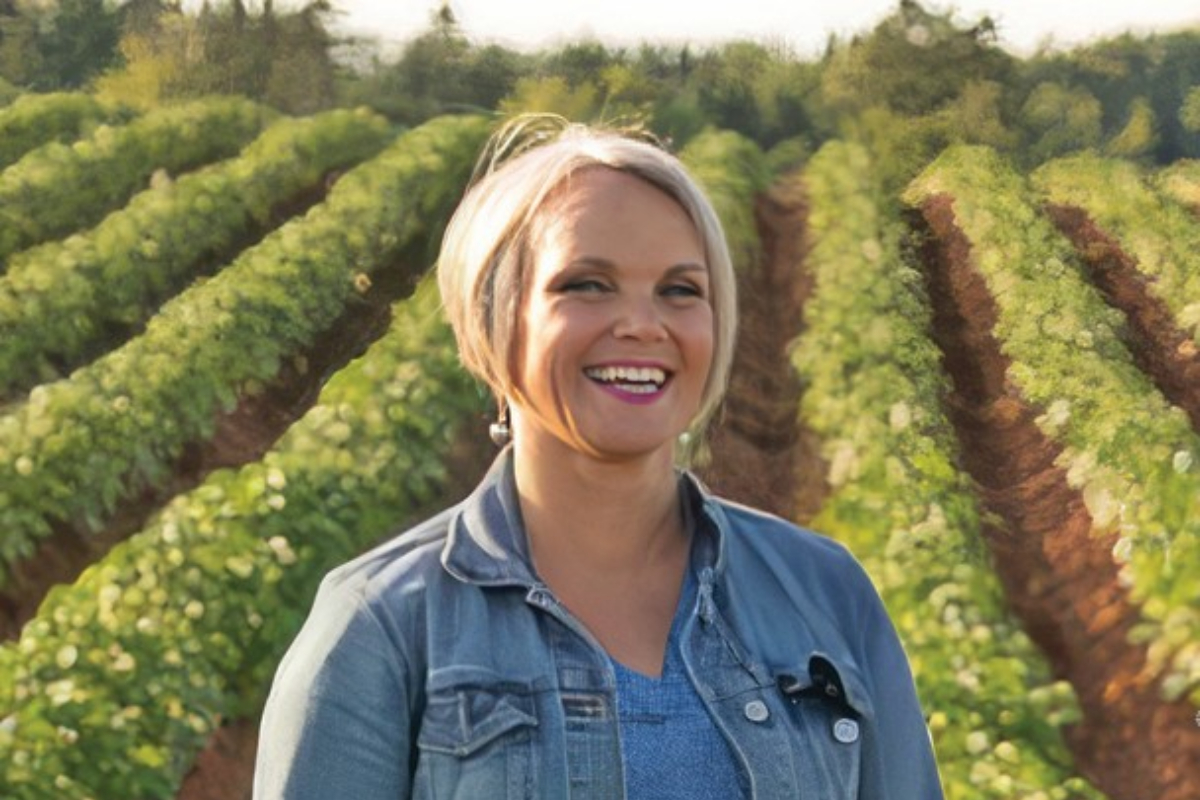Mary Robinson is a prominent Canadian agricultural industry figure and a managing partner of Eric C. Robinson Inc. and Island Lime. She is involved in various aspects of the potato industry, including agronomy, food processing, and production. In addition to her work on the family farm, Robinson has taken an active role in industry politics and governance. Robinson’s involvement in industry politics began in 2008 when she joined the PEI Federation of Agriculture board. She served as President of the Federation from 2015 to 2017, leading efforts to advance the interests of farmers and agricultural businesses in the province. Robinson’s leadership and advocacy for the industry did not go unnoticed, and she was appointed the first female chair of the Canadian Ag HR Council in 2017. In 2019, she was appointed president of the Canadian Federation of Farmers and the first female president of the federation’s 84-year history.
She has also served on various government advisory councils. For example, from 2015 to 2017, two Ministers of Agriculture and AgriFood Canada selected her to serve on AAFC’s National Program Advisory Council, guiding agricultural programs and policies. In addition, the Federal Minister of Environment appointed her to serve on the Sustainable Development Advisory Committee, where she provided expert advice on environmental sustainability issues. Robinson’s extensive experience in executive and governance roles and her expertise in the potato industry makes her a valuable asset to the Canadian agricultural industry. In addition, her dedication and commitment to advancing the interests of farmers and agricultural businesses have made her a respected leader in the industry. In her role, she serves on the Board of The World Farmers’ Association (WFA), an international organization that represents the interests of farmers and their organizations globally. The Edge chatted with Robinson about her ongoing commitment to helping improve farmers’ lives worldwide.
You served as the President of the Canadian Federation of Agriculture for four years and the first female President throughout the organization’s 84-year history. How did your agricultural experience prepare you for the role?
I was raised in a relatively agricultural community in Canada (Prince Edward Island), where women’s role in Agriculture is not a complete rarity. My mother was a trailblazer, especially in improving our woodlands, watercourses, roads, and bridges. Don’t get me wrong — we still need to work to remove barriers for women to take on leadership roles in Agriculture advocacy, and I’m proud to see that work gaining much-needed momentum across the country.
I’m one member of the 6th generation in my family to farm. We’ve been farming in the same area since 1810. Over the years, we have diversified within agriculture, having businesses that offer agricultural inputs, custom applications, potato packaging, potato dealership, and more. Through my family’s agriculture businesses, I assisted in managing operations by sitting on several boards and learning how governance works.
My parents raised their children with the mantra that ‘if you want things to improve, get involved’; that is what I did when our second child was only two years old. So I reached out to my local Federation of Agriculture for an opportunity to take on a role, and it all seemed to come together quite quickly.
I moved from county rep to executive member, elected as the third female President of the Prince Edward Island Federation of Agriculture, and to national organizations such as the Canadian Agricultural Human Resource Council (CAHRC). — of which I became the first female chair — and the board of the Canadian Federation of Agriculture (CFA). After completing my term as Chair of CAHRC, I was elected President of CFA. While on the CFA board, they appointed me as the World Farmers’ Organization Board member for North America. I continue to sit on this board and find it incredibly exciting.
Would you consider climate change, land degradation, and water scarcity as primary factors in the sector?
Without a doubt, these are significant factors that impact Agriculture. As farmers, we face the impacts of climate change first. Our crops, land, waterways, forests, buildings, and more have nowhere to hide from significant weather events. We have challenges making investments and preparing for weather incidents that may or may not ever happen.
These investments also benefit the general public through enhanced ecological goods and services. I can’t elaborate enough on how the general attitude of farmers is to improve our soil and water — it is the basis for each of us in what we grow and market; the health of our resources determines our farms’ long-term viability.
And I would also make the challenge to think of an industry that can do what agriculture can do: grow food, fibre, fuel, ornaments while simultaneously being one of the only industries that can boast of providing climate-change mitigation deliverables. What other industry can sustainably produce essential goods, continue improving carbon sequestration, and reduce emissions? We need the non-agricultural community to start recognizing and rewarding the potential agriculture represents to Canada in the fight against climate change.
Have you implemented any policies to manage risk in your agricultural operations, and what steps do you take to mitigate potential hazards or losses?
My grandfather was a true entrepreneur, and with my grandmother’s and their children’s help, he started diversifying our business in the 1940s. We have been taught long ago not to put all our eggs in one basket and, while cover story not straying far from agriculture, have tried to become involved in many components of our food chain. Speaking strictly on our farm side, we are committed to managing our wood lots (approximately 400 acres of woodlands) with a long-term view of sustainability. We work with local silviculturists (growers of forest trees) to cultivate biodiversity in our woodlands with no expectations to harvest trees.
Again, this is an investment on our part, with very little direct return to our bottom line. Unlike many businesses, not many farms are in a position to pass along the increased costs they incur. Farmers are price-takers and are, for the most part, at the whim of the commodity markets they sell in. These two examples I list (woodlot and extended rotation) will hopefully put our land and forests in a solid position for future weather occurrences.
How do you prioritize and manage your workload when faced with multiple demands or deadlines in your agricultural work?
I experience that people involved in advocacy work that takes them away from their families and agriculture businesses must set some hard lines. For example, I must say ‘no’ to all ‘off-farm’ work from late April to early June. Spring is a hectic time of the year, and in the agriculture business I manage (a custom application business), we do about 65% of our annual business in the 6-week window. Outside of spring, my priorities are family, an agriculture business, and advocacy. It can be a challenge, as it is unavoidable to get caught up in the passion of advocating for agriculture. However, I am incredibly appreciative of my supportive and encouraging husband; and a farm family supporting the work I do that takes me away from home and work at home.
Can you elaborate on some of the biggest challenges facing the agriculture industry today and how you see this playing out in the future?
Two of the more considerable challenges are climate change and labour. COVID indeed highlighted the fragility of our food supply chain. And the illegal war in Ukraine stressed how dependent Eastern Canada is on the nitrogen supply from Russia. Regarding climate change, I see no other option than for Canada to start to do more to position farmers to invest in increased technology to improve our opportunity to deliver more EGS (and carbon sequestration) and produce more food efficiently. It means financial rewards to enable farmers to invest in new technologies to get us there as a nation.
With labour, the CAHR Council, working with CFA and food and beverage manufacturers, is working on tangible deliverables to address the chronic labour shortages. In 2021, on-farm vacancies cost primary production over $2.9 billion. Consider all the additional losses down the value stream for agriculture products. That is staggering! CAHRC will identify these strategies, combined with a greater understanding that the value of the Temporary Foreign Worker programs used by farmers and processors will be primary components in addressing this chronic and concerning issue.
Do you use specific communication techniques to engage with stakeholders, suppliers, customers, or regulatory agencies, and how has it helped you build and maintain positive relationships?
It is always best to approach any engagement by developing a relationship. Over my tenure as CFA president, I spent much time and energy developing relationships with parties who, previously, would have been considered strange allies for CFA. I firmly believe that all the players in primary Agriculture have more than 90% in common. Unfortunately, it’s been our approach historically to focus on the less than 5% we disagree on and thereby let that prevent us from realizing our true potential in advocacy work.
My strategies are somewhat cliché. I try my best to listen hard, to learn and understand. I also do my utmost to build trust and never abuse that trust. From there, we are more likely to be able to move forward together. These foundational components in a relationship lay the groundwork to tackle some complex, sensitive issues.
Have there been any significant efforts to increase women’s involvement in agriculture in recent years?
In conjunction with the PEIFA, CFA is conducting a pilot project, “Leveling the Field,” to identify pathways to removing barriers to increasing women’s involvement in agriculture leadership roles. I can say that I’ve lost track of the many women who have quietly taken me aside to say ‘thank you.’ Honestly, it always shocks me, but the message is consistent — it means so much for women to see other women in these roles. “If you can see it, you can be it.”
Also, CAHRC long ago identified women as an under-utilized group of farm workers and has been helping identify and address barriers (such as childcare access in Rural Canada) that prevent some women from becoming involved in agriculture. Also, Agriculture in the classroom encourages ‘all walks of life’ to consider a career in agriculture. The stats of graduates from Agriculture programs in Canada show high numbers of women training for work in Agriculture – scientists, crop advisors, plant breeders, agriculture input advisors, and so on.
It’s been three years since COVID-19. How is the recovery in the agricultural industry, and what type of additional support do farmers need to continue their livelihoods?
COVID highlighted the fragility of our food supply chain. COVID showed us all that farms could not stop. You still have to pack those perishable crops, milk the cows, send the cattle to be processed, grade and pack the eggs — and then send it all to market. So it is not just because of perishability or the timeliness of an animal’s life; but because the world needs to keep eating, even in a pandemic.
The impact of COVID on farm labour set back some farms. It takes months or years to plan a crop or livestock. When you have an interruption like COVID, it takes a long time to recover, build momentum and get back on track.
Farmers need everyday Canadians to recognize how much agriculture contributes to our food, economics, and environmental security; and how much more we can do with greater confidence. We need to push Canadians outside agriculture to tell their MPs just how important agriculture is to our country to them; push our government to step up how much our nation invests in farmers.
We are the fifth-largest exporting nation in the world. However, with climate change impacting production in other parts of the world, it is time for Canada to step up and make agriculture one of the more critical portfolios of our government — through direct investment and by making Canada an attractive country for investment in value-added capacity.
I am always amazed that many Canadians seem oblivious to what a global sterling brand our Canadian-produced food has. We have one of the world’s most unique food safety systems that deliver nutritious, healthy and (by global standards) affordable food. Generally, we are the envy of the world when it comes to food production.
Can you tell us some specific examples of successful agricultural projects or initiatives you have participated in and how you contributed to their success?
During my tenure as President of CFA, we undertook the most extensive campaign in the history of CFA, called “Food for Thought.” The project launched in response to the many pressures Canadian Agriculture faced in the early days of COVID. We saw an opportunity where Canadians, many for the first time in their lives, were facing food scarcity.
It also piqued an interest for everyday Canadians in Canadian agriculture and food production that we rarely see. For example, in agriculture, there is a bit of a joke that because food production usually goes without a hitch, people never have to consider where their food comes from; or what are some of the challenges and areas of concern that producers might face.
Our goal with “Food for Thought” was to move the needle on the level of federal government investment in our Business Risk Management (BRM)suite of programs. Most, if not all, developed nations have programs that protect farmers when extenuating circumstances challenge their financial ability to stay in business. Unfortunately, the Canadian government gutted our BRM programs in 2014. Not only was the support level dropped, but from that moment, the program had not even kept up with the pace of inflation.
Our “Food for Thought” campaign was a fantastic success. It resulted in an increased level of investment by the government. It also changed some of the triggers that made the programs relatively ineffective. Still, the campaign brought together some unlikely groups and, in my opinion, created an awareness of the impact of a more prominent, united voice for Canadian Agriculture.
The NCFA will host the annual A/EU Farm Leaders Conference in beautiful Prince Edward Island, September 16 the EDGE Summer 2023 12-14. What are some of the benefits it will provide farmers — local and international?
The NAEU offers a venue to share and learn of some of the challenges and successes other jurisdictions have experienced. Attending the last of these conferences (Copenhagen 2019) gave us insight into some challenges farmers in the EU faced and how they responded. It is probably fair to say that many of the pressures agriculture experiences in the EU are a bit of a portal into what we may experience soon in North America. And it is always an excellent experience to come together with our industry members, network and learn, which goes for any industry, not just Agriculture.
The NAEU in PEI this September will also offer a fantastic opportunity for us to showcase many of the practices we employ in local agriculture. For example, I recently took part in the United Nations Water Conference. As a result, some European groups informed me that legislated practices designed to protect soil health and watersheds in PEI are years ahead of what they employ in parts of Europe.
You recently started a new role at the World Farmers Association. Can you tell us more about it?
I started this role in June 2020. The WFO (World Farmers Organization) is the farmers’ voice on the global stage. WFO is based in Rome and is mandated to represent and advocate for the world’s farmers in all relevant international processes affecting farmers’ present and future, covering the global dialogue on agriculture nutrition and sustainability.
Sitting at the WFO table is incredibly interesting, as we have board members from Europe, Asia, Oceania, Africa, and North America. Taking farm-level issues from each constituency to the international stage is challenging. Although, at first glance, you might wonder what a farmer in Saskatchewan has in common with one from Cambodia, a deeper dive changes your perspective, and you realize a rising tide lifts all boats.
Finally, how can citizens and other sponsors become more involved in shaping the future of the agriculture sector in Canada, and what opportunities are available for engagement and collaboration?
My suggestions are to please speak to your MP to emphasize your concerns about our Canadian farm families, food security, and sustainability. Get informed — challenge the information you read on Agriculture. Make sure it is science-oriented, not fear-mongering. Embrace science and realize we would have a global food crisis without science. I mean plant breeding, gene editing, crop protectants (why should we be able to use medicine to keep our bodies well but deny farmers using similar products to keep plants healthy when they face disease or insect pressure?) and more.
Food production is such an exciting and fast-paced world: seek out and get more info on it, and reach out to a local federation of agriculture. And I would strongly recommend subscribing to the Canadian Federation of Agriculture’s “Food for Thought” newsletter. It’s a fantastic resource for Canadians wanting better visibility into Agriculture in Canada.
Jennifer M. Williams | Editor-in-Chief




















